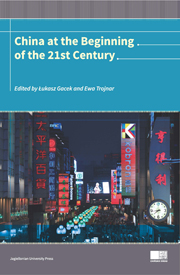Book contents
- Frontmatter
- Contents
- Acknowledgements
- Preface
- Chapter One Dagongmei in the Context of Rural-urban Migration Processes in Contemporary China
- Chapter Two The Linguistic Features of Chinese Internet Language
- Chapter Three Chinese Contemporary Art: Between Market and Freedom
- Chapter Four The Modernization of the People's Liberation Army since 1978
- Chapter Five The Reduced Role of the People's Liberation Army in the Political Succession to Deng Xiaoping and to Jiang Zemin: Chinese Style Civilian-Military Relations in the Making
- Chapter Six Chinese Involvement in Southeast Asia on the Example of Myanmar
- Chapter Seven China's Energy Policy towards Central Asia and Russia
- Chapter Eight Sino-Japanese Dispute over the Seabed Oil and Gas Resources in the East China Sea
- Chapter Nine China's Territorial Disputes in the South China Sea
- Chapter Ten The Way to Hong Kong Handover and its Implications
Chapter Three - Chinese Contemporary Art: Between Market and Freedom
Published online by Cambridge University Press: 05 September 2014
- Frontmatter
- Contents
- Acknowledgements
- Preface
- Chapter One Dagongmei in the Context of Rural-urban Migration Processes in Contemporary China
- Chapter Two The Linguistic Features of Chinese Internet Language
- Chapter Three Chinese Contemporary Art: Between Market and Freedom
- Chapter Four The Modernization of the People's Liberation Army since 1978
- Chapter Five The Reduced Role of the People's Liberation Army in the Political Succession to Deng Xiaoping and to Jiang Zemin: Chinese Style Civilian-Military Relations in the Making
- Chapter Six Chinese Involvement in Southeast Asia on the Example of Myanmar
- Chapter Seven China's Energy Policy towards Central Asia and Russia
- Chapter Eight Sino-Japanese Dispute over the Seabed Oil and Gas Resources in the East China Sea
- Chapter Nine China's Territorial Disputes in the South China Sea
- Chapter Ten The Way to Hong Kong Handover and its Implications
Summary
It was something to be expected a few years ago. In the wake of the booming Chinese economy, the Chinese art market would take off sooner or later. It is not only the matter of visual and modern arts, the phenomenon is encompassing the entire cultural sphere in China. Some ask the question is the Chinese art dead or indeed is it really being reborn after years of vegetation under the communist rule, and if so, to what form? To answer this question we must first analyze the phenomenon called the Chinese contemporary art, on the grounds of its history and present. We must furthermore ask a very important question about art in general. This question has been tormenting researchers from at least the beginning of the 20th century. Is art understood as creation of art works, looking for answers, trying to express feelings and emotions, is this notion gone and what replaced it? Is art really being produced now, like any other market commodity, to be sold out? In China, this questions are even more complicated. Some argue that there could be no art without freedom, that art is freedom. But is it really so easy to define this most complex of notions?
The beginning of “Chinese contemporary art”
At the beginning of the 20th century, China entered a new era in its long history. The first decades of this century marked the end of the tradition-bound and inefficient Qing Empire.
- Type
- Chapter
- Information
- China at the Beginning of the 21st Century , pp. 35 - 48Publisher: Jagiellonian University PressPrint publication year: 2014



